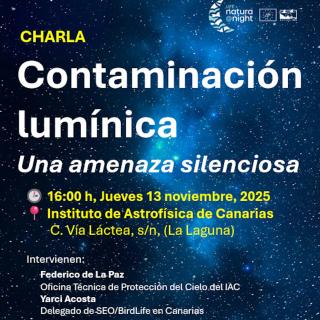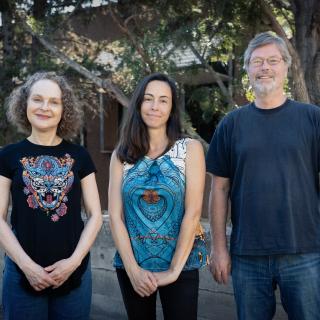El Instituto de Astrofísica de Canarias (IAC) ha organizado, como cada año, una nueva edición de su Canary Islands Winter School of Astrophysics (Escuela de Invierno de Astrofísica de Canarias), del 19 al 30 de noviembre, en el Centro de Congresos del Puerto de la Cruz, Tenerife. Esta decimotercera edición estará dedicada a la "Cosmoquímica: el crisol de los elementos" y contará con la financiación de la Unión Europea y la colaboración de la compañía Iberia.
En esta Escuela de Invierno los cursos son impartidos por ocho profesores expertos en Cosmoquímica que abordan el tema desde diferentes puntos de vista. Participan 63 alumnos de 18 países que actualmente preparan su tesis doctoral, o la han terminado recientemente, sobre un tema relacionado con el de esta Escuela. Los cursos se completan con las visitas al Instituto de Astrofísica, en La Laguna, y a los Observatorios del Roque de los Muchachos, en La Palma, y del Teide, en Tenerife.
Dentro de los actos previstos durante la Escuela, el martes 20, a las 19:30 horas, en el Museo de la Ciencia y el Cosmos de Tenerife, el Prof. Gary Steigman, de la Universidad Estatal de Ohio (EEUU), pronunciará una conferencia de divulgación abierta al público sobre "Conexiones cósmicas: del Big Bang al Universo en expansión acelerada."
LA QUÍMICA DEL COSMOS
La evolución de la composición química de los objetos en el Universo es una historia de miles de millones de años que comenzó pocos minutos después de la Gran Explosión. Comprender por qué los objetos celestes tienen las abundancias químicas que observamos es un proceso muy complejo que requiere conocer qué elementos se generaron en el momento de la creación del Universo, cómo se forman en las estrellas, cuántas se han producido, cómo evolucionan, cuáles son los elementos químicos que sintetizan las estrellas, la importancia de los flujos de gas y un sinfín de otros procesos de distinta importancia.
Los avances realizados en el estudio de la composición y evolución química del Universo en la última década del siglo XX han sido realmente espectaculares. Por una parte, debidos a la disponibilidad de telescopios terrestres de gran abertura y de telescopios espaciales en órbita (trabajando tanto en el óptico como en otros rangos del espectro electromagnético) y, por otra, a los avances en la teoría y los métodos de modelización numérica en numerosos campos de la astrofísica, como evolución estelar, atmósferas estelares, física de plasmas ionizados, así como en física atómica y molecular.
La principal originalidad de esta XIII Escuela de Invierno es reunir en un único evento científico los tremendos avances, tanto observacionales como teóricos, que ha experimentado el amplio campo de la Cosmoquímica en la última década. Para conseguir este objetivo, la Escuela de Invierno trata aspectos claves del tema general de la composición y evolución química del Universo y que comprenden tanto contenidos observacionales como teóricos y cubren los fundamentos físicos, los desarrollos históricos, los avances más recientes y los desafíos futuros. La versión escrita de las lecciones se publicará tras finalizar la Escuela por Cambridge University Press y el volumen resultante será una referencia básica en los trabajos de Cosmoquímica en el futuro.
RELACIÓN DE CONFERENCIAS Y PROFESORES:
· "Moléculas en el cosmos"
JOSÉ CERNICHARO. Instituto de Estructura de la Materia, Consejo Superior de Investigaciones Científicas (España)
· "Abundancias de elementos en galaxias cercanas""
DONALD R. GARNETT. Steward Observatory, Universidad de Arizona (EEUU)
· "Abundancias estelares"
DAVID L. LAMBERT. Universidad de Texas en Austin (EEUU)
· "Nucleosíntesis estelar"
NORBERT LANGER. Universidad de Utrecht (Países Bajos)
· "Modelos de evolución química de galaxias y medio interestelar"
FRANCESCA MATTEUCCI. Universidad de Trieste (Italia)
· "Abundancias de elementos a lo largo de las épocas cósmicas"
MAX PETTINI. Instituto de Astronomía, Cambridge (Reino Unido)
· "Determinacioness de abundancias en regiones HII y nebulosas planetarias"
GRAZYNA STASINSKA. Observatorio de París-Meudon (Francia)
· "Alquimia primordial: del Big Bang al Universo actual"
GARY STEIGMAN. Universidad Estatal de Ohio (EEUU)
COMITÉ ORGANIZADOR:
César Esteban López (IAC/ULL)
Artemio Herrero Davó (IAC/ULL)
Ramón García López (IAC/ULL)


